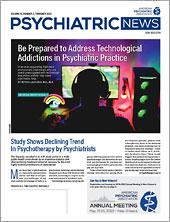Substance use disorders (SUDs) have long been linked to an increased risk of suicide, but many of the studies suggesting this link have been small. Now researchers in a large population-based study in the Journal of Psychiatric Research have determined the risk of suicide associated with specific SUDs.
Quantifying risk for patients with each SUD may help mental health professionals allocate resources, said study researcher Alexis Edwards, Ph.D., an associate professor in the Department of Psychiatry at Virginia Commonwealth University in Richmond.
“There are limited resources for addressing suicide prevention and intervention, so this can help clinicians [identify] who they should be paying the closest attention to,” Edwards told Psychiatric News. “This isn’t to say they shouldn’t worry about other patients with risk, but that knowing which substance use disorders have the highest risk can help them target the limited resources they have.”
Edwards and colleagues examined data from more than 6.9 million adults in the Swedish Total Population Register who had lived in Sweden for at least two years as of January 1, 2003. They obtained data from the Swedish Cause of Death Register to determine the prevalence of suicide death in this population from January 1, 2003, through December 31, 2016. They also obtained data about the prevalence of SUDs involving opioids, sedative/hypnotics, hallucinogens, cannabis, amphetamine, cocaine, alcohol, and multisubstance SUDs from various Swedish health registries.
Overall, 15,616 people in the study, or 0.2% of the total study population, died by suicide. Compared with people who did not have an SUD, those who had any SUD had 3.67 times the risk of suicide death, and those with multisubstance use disorders had 3.87 times the risk. People with opioid use disorder had 6.39 times the risk of death by suicide, followed by those with SUDs involving sedative/hypnotics, hallucinogens, cannabis, amphetamine, cocaine, or alcohol, who had 4.62, 4.11, 3.10, 2.76, 2.73, and 2.55 times the risk, respectively.
In a secondary analysis, the researchers controlled for familial factors, such as shared genes and exposure to parental divorce, low socioeconomic position, or other stressors. Results from these models indicated that risk increased further for people with alcohol use disorder compared with those without SUD. Risk remained significantly elevated, although slightly less so, for people with opioid use disorder and sedative/hypnotics use disorders compared with people without SUD.
“Even when controlling for familial factors that might contribute [directly] to suicidal behavior, we still see these residual associations between SUD and suicidal behavior,” Edwards said.
In another secondary analysis, the researchers looked at deaths of undetermined intent and found that 44.3% of deaths in people with SUD had undetermined intent compared with 17.6% of deaths among people without SUDs.
“This is not surprising because deaths of undetermined intent tend to be overrepresented among people with SUD. It can be difficult to tell if a suicide was intentional [in this population],” Edwards said.
This study was supported by the National Institute on Alcohol Abuse and Alcoholism, the Swedish Research Council, and Region Skåne. ■
“Comparative Risk of Suicide by Specific Substance Use Disorders: A National Cohort Study” is posted
here.

